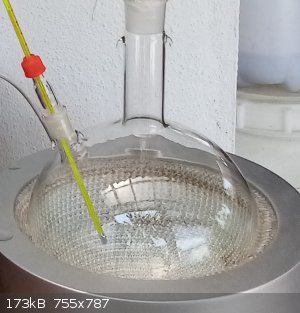Fyndium
International Hazard
    
Posts: 1192
Registered: 12-7-2020
Location: Not in USA
Member Is Offline
|
|
Absolute volume of vessels?
I noticed when I carried out a reaction and calculated the volume wrong accidentally that a flask of designated volume had very much headspace even
though it was supposed to be full. So I measured it out volumetrically and found out that it is at least 25% bigger and it could be very well filled
to 100% of designated volume with reaction mass that is no in risk of boiling over or foaming. Sometimes when designing and scaling synthesis the size
of vessel becomes the limiting number, so it seems to be good to know the actual volume.
Are glassware designed so they are a bit oversize or is this a deviation of quality control? Does the number mean the maximum useable volume or
absolute volume?
For the record, the standard procedure is to use maximum of 50% of flask volume. I've deviated from this when I have a reaction that could be handled
with less headspace without risk because there were no bigger vessels available or it was more convenient to use this size for various reasons.
Sometimes the glassware could be filled basically to 100%, for example I did this in an isomerization reaction where a solution is just stirred at ntp
for a given time and there were about an inch of headspace in the neck to the stopper.
[Edited on 2-12-2020 by Fyndium]
|
|
|
UC235
National Hazard
   
Posts: 565
Registered: 28-12-2014
Member Is Offline
Mood: No Mood
|
|
Glassware is all over the place in my experience. I have 100ml flasks that are probably 80ml and I have ones that are 120ml. Depends on the
manufacturer. I would assume newer glass might be more consistent but who knows.
|
|
|
Sulaiman
International Hazard
    
Posts: 3723
Registered: 8-2-2015
Location: 3rd rock from the sun
Member Is Offline
|
|
I just checked the capacity of my generic Chinese 1000ml rbf,
when filled to the top of the globe = the bottom of the neck... almost exactly 1400ml
CAUTION : Hobby Chemist, not Professional or even Amateur
|
|
|
HydrogenSulphate
Harmless

Posts: 38
Registered: 13-10-2019
Member Is Offline
Mood: Caffeinated
|
|
If your experiment requires absolute confidence in the degree of accuracy of liquid volumes, then use volumetric glassware (volumetric flask,
volumetric pipette, burette). Non-volumetric general lab glassware such as beakers only provide an approximate measuring capacity, so if the exact
volume of liquid is not critical, then these can be used in such instances.
[Edited on 2-12-2020 by HydrogenSulphate]
|
|
|
Sulaiman
International Hazard
    
Posts: 3723
Registered: 8-2-2015
Location: 3rd rock from the sun
Member Is Offline
|
|
Quote: Originally posted by Fyndium  | ... so it seems to be good to know the actual volume.
...
For the record, the standard procedure is to use maximum of 50% of flask volume. I've deviated from this when... |
I needed to keep the liquid level in a 5l rbf above the heating element to prevent the unfilled glass from overheating.
P. S. from memory... my 500ml rbfs were all of a similar size and the diameter was about right for the volume.
The rbf that I have here is from a 1000ml distillation kit.
I measured while filling from a 100ml measuring cylinder,
I was so sure that I'd miscounted that I emptied the rbf via the measuring cylinder,
just to be sure I filled the rbf again and got my wife to count also... 1400ml.
I have a PYREX 5l rbf that I will measure if I get bored enough (max cal. volumetric is 100ml=50 pourings)
CAUTION : Hobby Chemist, not Professional or even Amateur
|
|
|
Fyndium
International Hazard
    
Posts: 1192
Registered: 12-7-2020
Location: Not in USA
Member Is Offline
|
|
Why not take a scale and measure the water?
|
|
|
Sulaiman
International Hazard
    
Posts: 3723
Registered: 8-2-2015
Location: 3rd rock from the sun
Member Is Offline
|
|
That is exactly what I intended to do after I wrote the above
but
I forgot that the 5l rbf has a second (19/26) neck lower than the main (34/35) neck so difficult to actually fill.

CAUTION : Hobby Chemist, not Professional or even Amateur
|
|
|
Morgan
International Hazard
    
Posts: 1705
Registered: 28-12-2010
Member Is Offline
Mood: No Mood
|
|
This way of measuring was somewhat illustrative and muddling through the more critical comments on the video a bit more is learned. Just before the 4
minute mark he finds the roughly 25 ml pycnometer is off over 5 ml. But then you can have them engraved/calibrated someone commented.
https://youtube.com/watch?v=StGbFkSevy0
[Edited on 3-12-2020 by Morgan]
|
|
|
Fyndium
International Hazard
    
Posts: 1192
Registered: 12-7-2020
Location: Not in USA
Member Is Offline
|
|
I was thinking on taking a day to measure the weight and volume of all my glassware and making a list of it so at certain times I could just check it.
|
|
|
Sulaiman
International Hazard
    
Posts: 3723
Registered: 8-2-2015
Location: 3rd rock from the sun
Member Is Offline
|
|
In the back of my lab book I have a page for tare weights of;
. volumetric flasks, with and without paired stopper
. my favourite measuring cylinders, beakers and flasks.
If you make/have a meticulous plan for each of your experiments, and follow the plan,
then you would collect all required data as a part of the experiment,
so you would rarely use that page,
I use that page quite often
CAUTION : Hobby Chemist, not Professional or even Amateur
|
|
|